Blog
Cloud Phone System
What is Cloud Contact Center? Benefits, Features, and How It Works

What is Cloud Contact Center? Benefits, Features, and How It Works
A cloud-based call center offers small businesses a flexible and cost-effective alternative to traditional setups. Let’s explore what it is and how it operates.
Businesses of all sizes, especially startups and small businesses, are embracing cloud solutions to build their infrastructure, and contact centers are no exception. Traditional contact centers with on-premises phone systems can be costly and inflexible to maintain. A cloud-based contact center offers a modern alternative: it is easy to implement and manage, enabling businesses to run a fully functional contact center without the need for expensive onsite hardware.
This blog post will provide a comprehensive overview of what a cloud contact center is, how it works, and its key features and benefits.
What Is a Cloud Contact Center?
A cloud contact center, sometimes referred to as CCaaS, or Contact Center as a Service, is a web-based solution that combines all the technologies needed to handle inbound and outbound customer communications, hosted entirely in the cloud. Because everything runs on your provider’s cloud infrastructure, it eliminates the need for on-premises hardware and software.
Agents can log in from any device — desktop, laptop, or mobile — and manage calls, SMS, and chat from a single centralized platform.
Cloud-based call center solutions reduce costs, streamline operations, and enable businesses to deliver flexible, global support without being tied to a physical location.
Cloud Contact Center vs. Cloud Call Center
Although the terms are often used interchangeably, there is an important distinction between them. The difference lies in the communication channels available to customers. A cloud contact center allows agents to connect with customers across multiple channels such as phone calls, SMS, chat, email, and even social media. In contrast, as the name suggests, a cloud call center is limited to voice calls only.
How Does a Cloud Contact Center Work?
A cloud contact center runs on a centralized platform that serves as the backbone for all contact center operations, hosted in the cloud. Businesses can deploy this platform in their own cloud environment, but more commonly, they rely on cloud contact center software provided by third-party cloud contact center providers.
Unlike traditional on-premises contact centers, cloud solutions don’t require businesses to purchase, install, or maintain telecom hardware. Instead, calls and messages are transmitted using Voice over Internet Protocol (VoIP) technology.
Because everything operates over the internet, all your team needs is workstations, headsets, and a reliable connection. While specialized devices like VoIP desk phones can be used, cloud contact center solutions work seamlessly on the computers and mobile devices you already have.
Cloud-Based vs On-Premises Contact Center: Why Are Businesses Moving to Cloud
What’s the real difference between a cloud contact center and a traditional on-premises setup? It’s a common question, especially for those familiar with conventional business phone systems. Below is a breakdown of the key distinctions:
Infrastructure & Ownership
An on-premises contact center is fully owned and managed by the business, requiring upfront investment in PBX systems, servers, and phone lines. By contrast, a cloud contact center is hosted in the provider’s cloud infrastructure, meaning the hardware and systems are off-site and maintained by the vendor. Instead of owning telecom equipment, you just subscribe to the service.
Cost Structure
On-premises systems usually demand high upfront costs for equipment, installation, and licensing, plus ongoing expenses for IT maintenance and periodic upgrades. Cloud contact centers eliminate most capital expenses, replacing them with predictable subscription fees (monthly or annual). While cloud pricing is recurring and often tied to the number of users or usage, it typically proves more cost-effective over time, especially as businesses pay only for what they need.
Scalability and Flexibility
Expanding an on-premises contact center, whether to add more lines or agents, can be time-consuming and costly, often requiring new hardware. In the cloud, scaling is fast and simple: businesses can add users, features, or channels almost instantly through the provider’s admin portal.
Feature Availability and Innovation
Cloud contact center providers continually release new capabilities, such as AI-powered tools, omnichannel messaging (chat, SMS, WhatsApp, social), and advanced analytics, that become available to subscribers right away. In contrast, on-premises systems often require additional modules, upgrades, or new hardware to gain similar functionality.
Maintenance and IT Burden
On-premises setups place the responsibility of troubleshooting, patching, and upgrading on the in-house IT team. If servers fail or software crashes, it’s up to your business to resolve the issue. Cloud solutions offload this burden to the provider, with your team only needing to maintain internet connectivity and end-user devices.
Reliability and Disaster Recovery
On-premises systems are vulnerable to local outages such as power failures or natural disasters. Cloud providers typically operate across multiple redundant data centers with built-in disaster recovery, delivering higher uptime and resilience. The only dependency is internet access, though backup connections or mobile failover strategies can minimize risks.
Security and Compliance
While some organizations worry about security in the cloud, leading providers usually implement stronger safeguards than most small businesses could achieve on their own. This includes encrypted communications, secure data centers, compliance certifications, and frequent audits. On-premises systems shift the full responsibility for updates and compliance to your IT team.
Control and Customization
On-premises systems offer full control and deep customization, assuming you have the expertise and resources. Cloud solutions, while configurable, may have some limits to customization because they are standardized services. However, most providers offer a wide range of settings and integration APIs to tailor the system to your needs.
So, while on-premises solutions may still be viable for organizations with highly specific requirements or legacy infrastructure, for most businesses the advantages of a cloud contact center, such as agility, scalability, and lower maintenance, make it the better choice for moving contact center operations to the cloud.
Related reading: Read about traditional phone systems and their evolution from on-premises setups to cloud solutions.
Types of Cloud Contact Center
Cloud contact centers can be categorized in different ways, but one of the most common distinctions is based on the direction of calls:
Inbound Contact Centers
Inbound cloud contact centers focus on receiving communication from customers. They are designed to efficiently manage large volumes of service and support inquiries. Common use cases include customer support hotlines, technical help desks, and order management lines.
Related reading: Learn more about inbound call centers.
Outbound Contact Centers
Outbound cloud contact centers are primarily used for reaching out to customers and prospects. Agents make calls to conduct sales outreach, lead generation, customer follow-ups, market research, or proactive engagement.
Related reading: Learn what an outbound call center is and why it’s important for businesses.
Another way to distinguish contact centers is by how they manage various communication channels:
Multichannel Contact Centers
A multichannel cloud contact center enables agents to handle customer interactions across various channels, such as calls, SMS, email, and web chat. However, each channel typically operates in its own silo. For example, a customer might call one day and email the next, but those two interactions are not linked. While multichannel setups expand communication options, they can lack visibility across different touchpoints.
Omnichannel Contact Centers
An omnichannel contact center is the most advanced type of cloud solution. It not only supports multiple channels but also integrates them into a seamless, unified customer journey. This means that if a customer starts with a chat and then switches to a phone call, the agent already has the full context from the previous interaction.
Benefits of Cloud Contact Center
Adopting a cloud contact center comes with a wide range of advantages for businesses. Here are some of them:
- Low setup and maintenance cost: Cloud contact centers eliminate the need for expensive on-premises hardware and dedicated phone lines. Instead, businesses pay a predictable subscription fee, reducing upfront costs and minimizing ongoing maintenance expenses.
- Fast installation and setup: Unlike traditional systems that can take weeks or even months to implement, cloud contact centers can be deployed quickly. Often, all you need is access to the cloud contact center platform and a few configuration steps in an intuitive interface.
- Ease of management: System updates, security patches, and feature enhancements are handled by the provider, reducing the burden on internal IT teams. Administrators can easily manage users, call routing, and reporting from a centralized dashboard.
- Built for remote work: Because everything operates over the internet, agents can log in from anywhere, whether at home, in the office, or on the go. This flexibility makes cloud contact centers a natural fit for hybrid or fully remote teams, ensuring customer service continues seamlessly regardless of location.
- Plenty of room for growth: Cloud solutions are highly scalable. Adding new users, phone numbers, or communication channels can be done instantly through the provider’s platform, making it easy to expand as your business grows.
- Better reliability: Cloud-based services are generally more reliable than on-premises systems. Local disruptions, from simple errors to major events like power outages or natural disasters, can bring traditional setups offline. In contrast, cloud contact centers are typically hosted in secure data centers with built-in failover protection, ensuring continuous service and minimizing downtime.
- Maximum productivity with advanced features: Most cloud based contact center solutions come with a robust set of features, even in entry-level packages. Beyond just phone numbers, you gain access to tools like intelligent call routing, analytics, CRM integrations, and AI automation that help your contact center operate more efficiently. As your business grows, you can easily add new capabilities by upgrading your plan, ensuring your team always has what it needs to perform at its best.
Key Features of a Cloud Contact Center Software
Modern cloud-based contact center software comes with a rich set of features designed to support all types of cloud contact centers. Depending on your business needs, some features may be more important than others. Below are the key features you can expect:
IVR Menus
Interactive Voice Response (IVR) menus enable inbound callers to handle many of their needs through self-service. Using their phone keypad, callers navigate a single or multi-level menu of options to reach the right department or information. This reduces wait times and minimizes the resources needed to manually route every call.
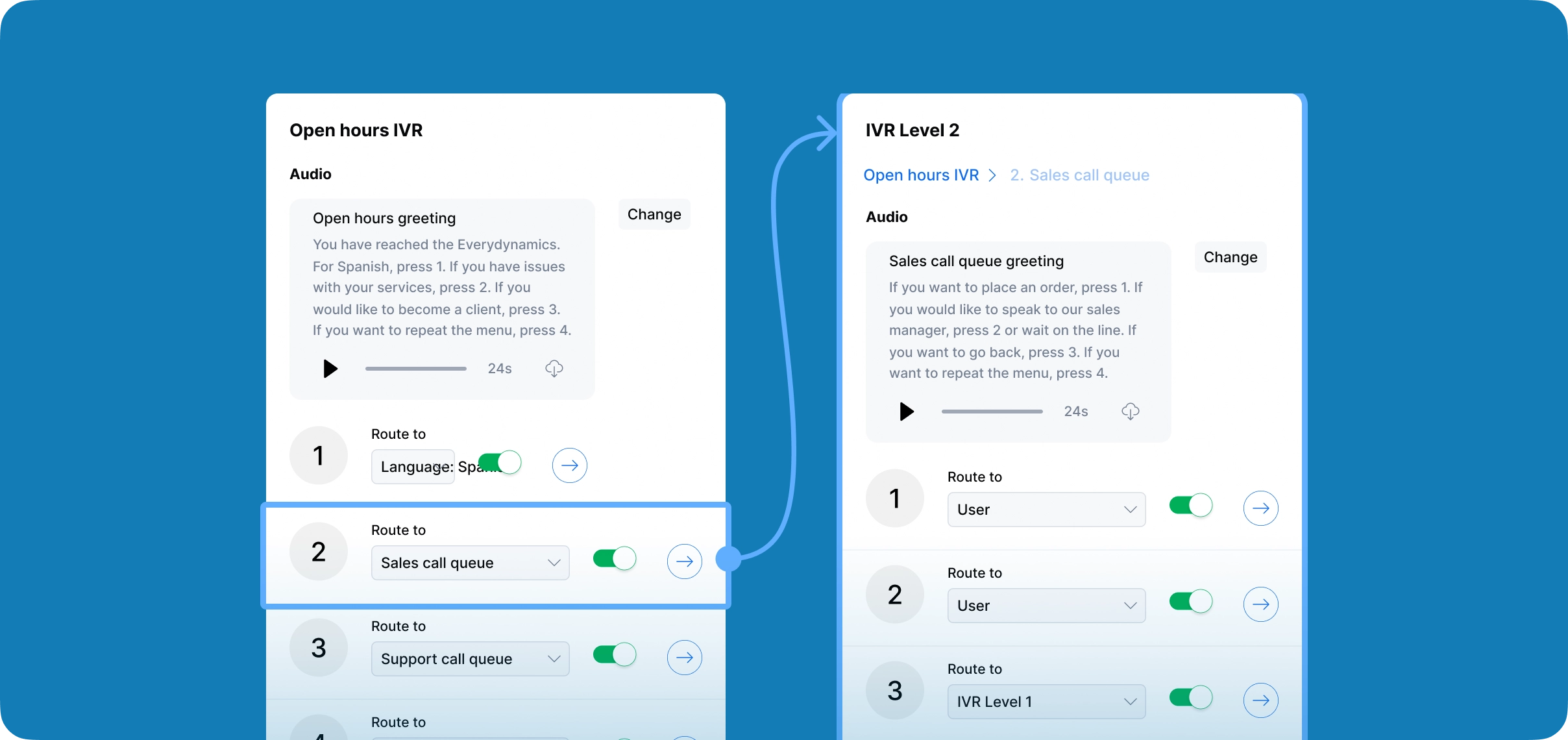
Auto-Receptionist
Instead of navigating an IVR menu by pressing buttons, customers can speak directly with an automated receptionist. This virtual receptionist greets callers and routes their calls to the appropriate department.
Call Routing
Call routing is a must-have for inbound contact centers, and providers offer various features to support flexible and efficient call flows. For example, an Automatic Call Distributor (ACD) intelligently routes incoming calls to the right agent or department based on rules such as availability, skills, or caller needs.
Call routing can also be configured with custom business hours. During working hours, calls are distributed among available agents according to your routing strategy or placed in a call queue. Outside of business hours, calls can be directed to voicemail, self-service options, or a virtual assistant.
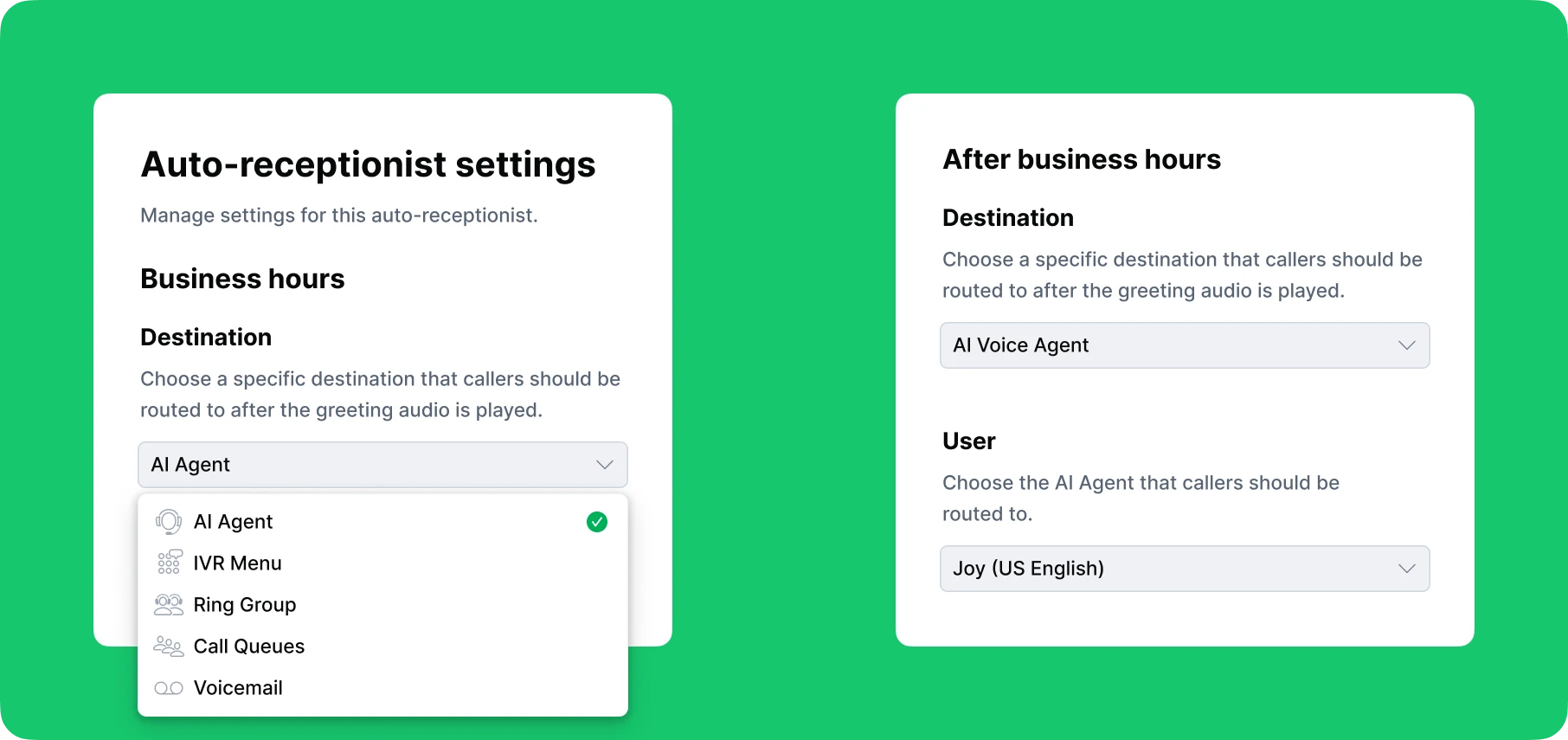
Call Queue
As businesses grow, they eventually face the challenge of handling more calls than available agents. This is where call queues help, holding callers in line until an agent is available and maintaining a professional experience. To further reduce frustration, many systems offer an automated callback option, allowing customers to request a return call instead of waiting on hold.
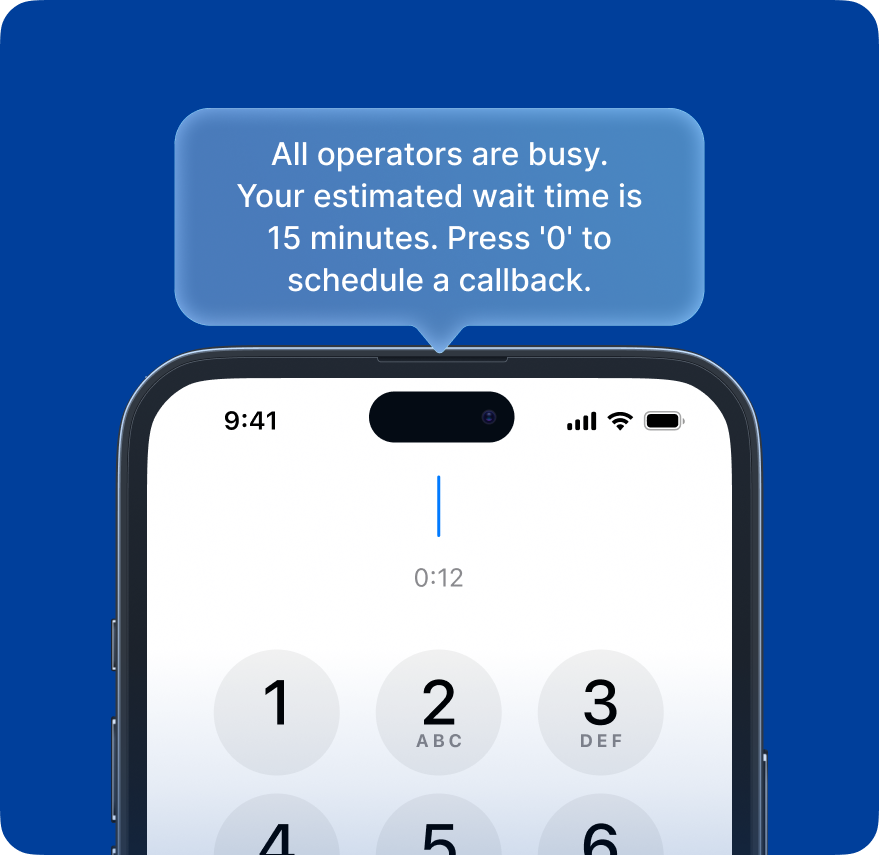
Auto Dialer
For automating outbound communications, auto dialers help teams place calls faster, minimize idle time, and increase agent productivity. With predictive and progressive dialing modes, businesses can run efficient outreach campaigns for sales, collections, surveys, and more.
Voicemail Management
Even with the best call handling, some calls will inevitably go unanswered. Cloud contact center solutions simplify this with centralized voicemail management, giving agents quick access to review and respond to messages.
Some platforms also include voicemail-to-email delivery or AI transcription, making follow-ups faster and more convenient.
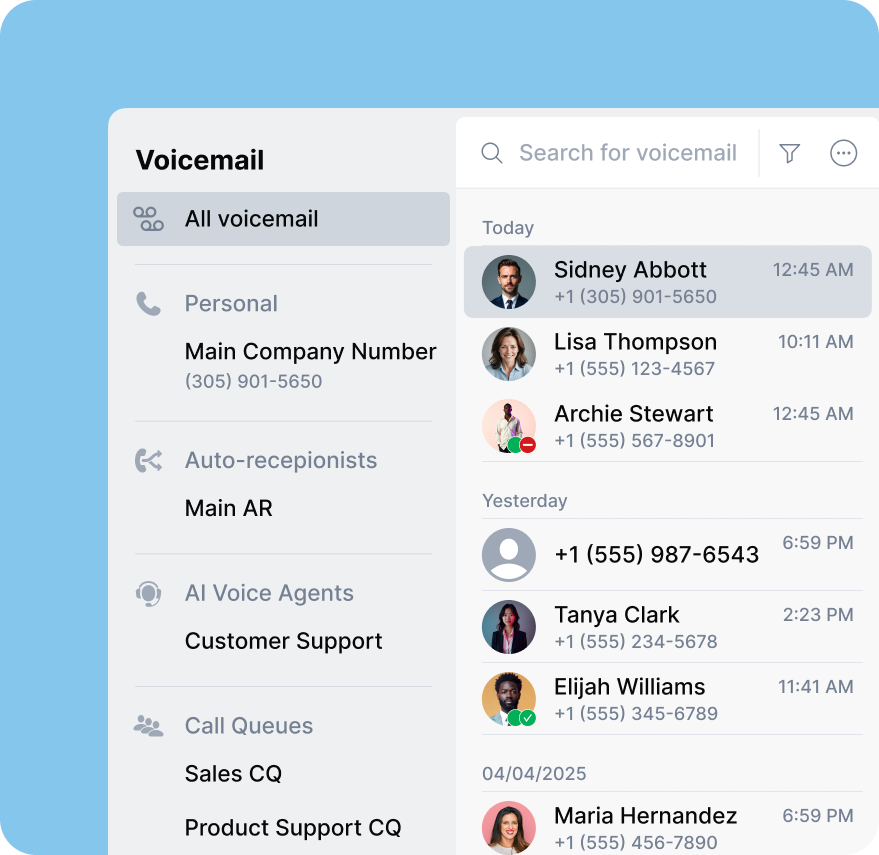
Call Recording and Monitoring
Call recording and monitoring tools are essential for quality assurance, compliance, and training. Supervisors can listen in on live calls, review recordings, and provide feedback to improve agent performance.
Related reading: Explore how call monitoring tools improve service quality and agent performance.
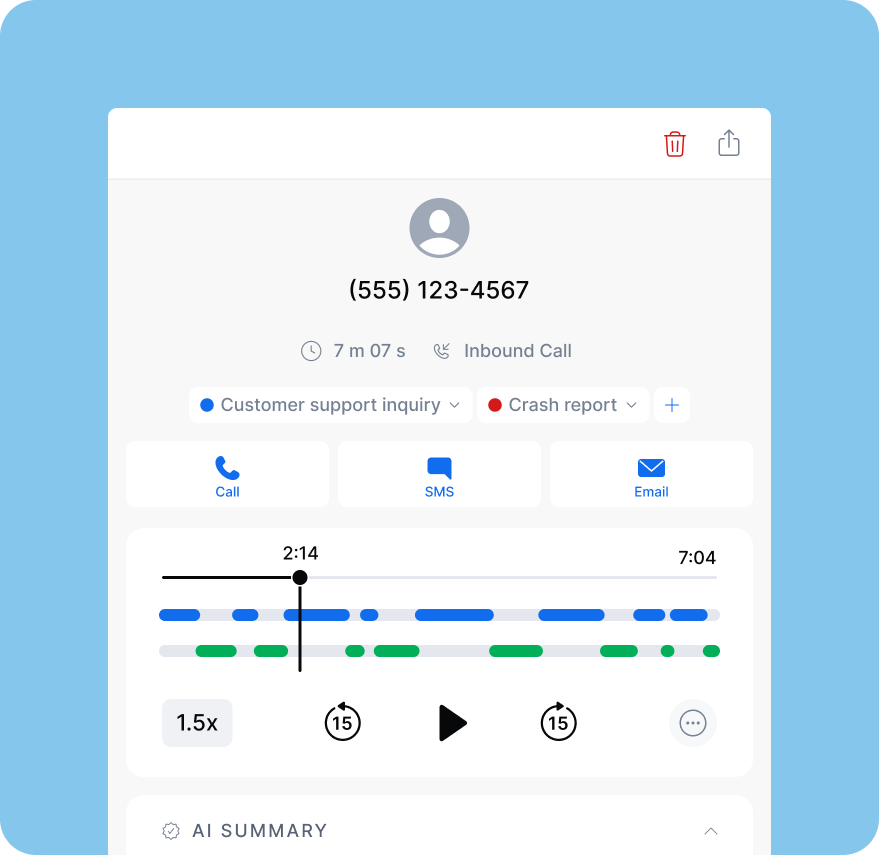
Omnichannel or Multichannel
Modern cloud contact centers allow businesses to engage with customers across multiple channels. Whether through a multichannel or omnichannel setup, today’s platforms support business messaging (SMS, RCS, and messengers like WhatsApp for Business), email, live chat, and social media. This ensures customers can reach you through the channel that’s most convenient for them.
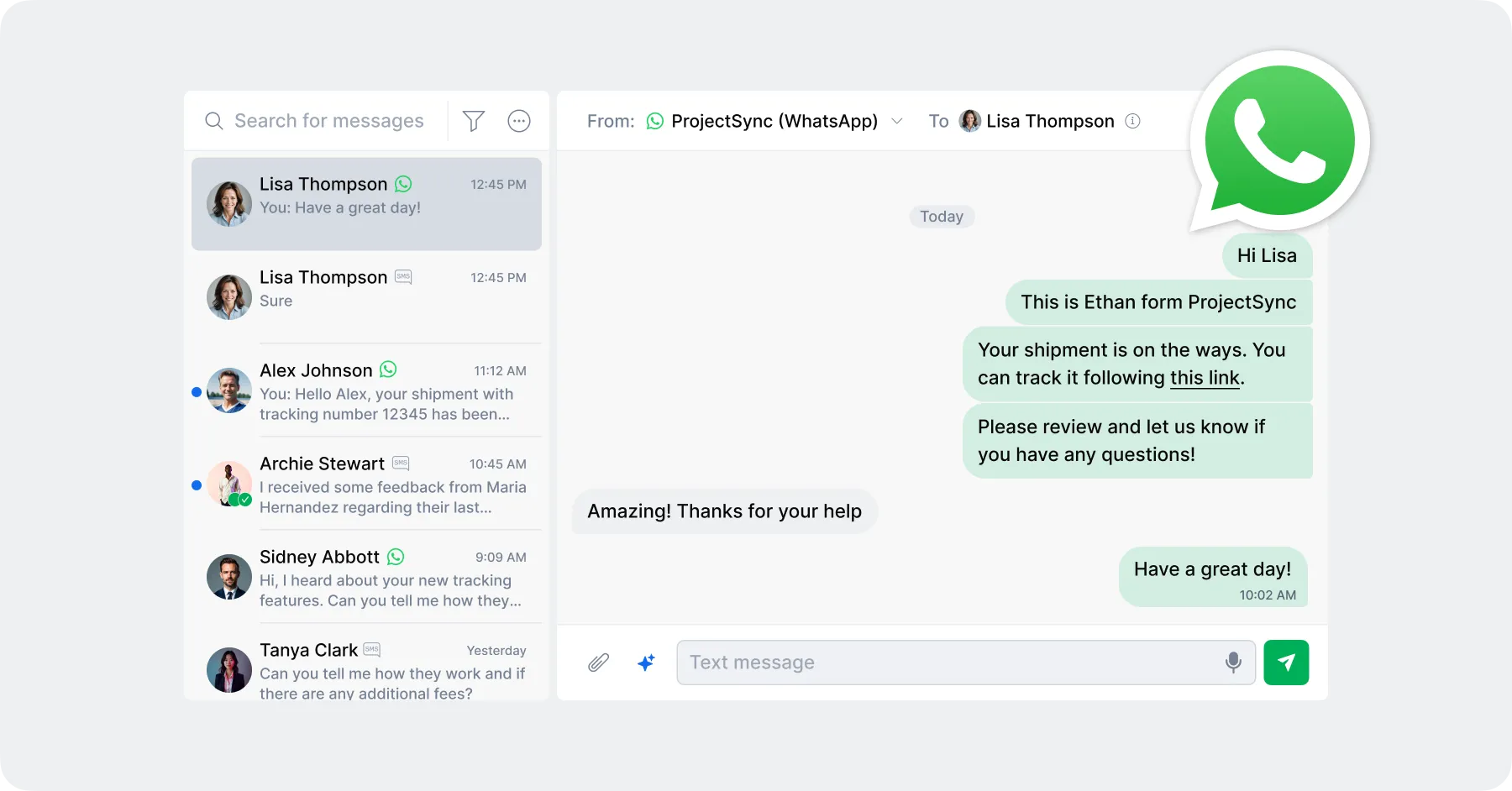
App Integrations
Most cloud based contact centers softwares connect seamlessly with popular business applications such as CRMs, help desk platforms, and productivity tools. These integrations give agents real-time access to customer data, enabling more efficient workflows and delivering personalized, context-aware interactions. They also ensure smooth data flows between your different systems.
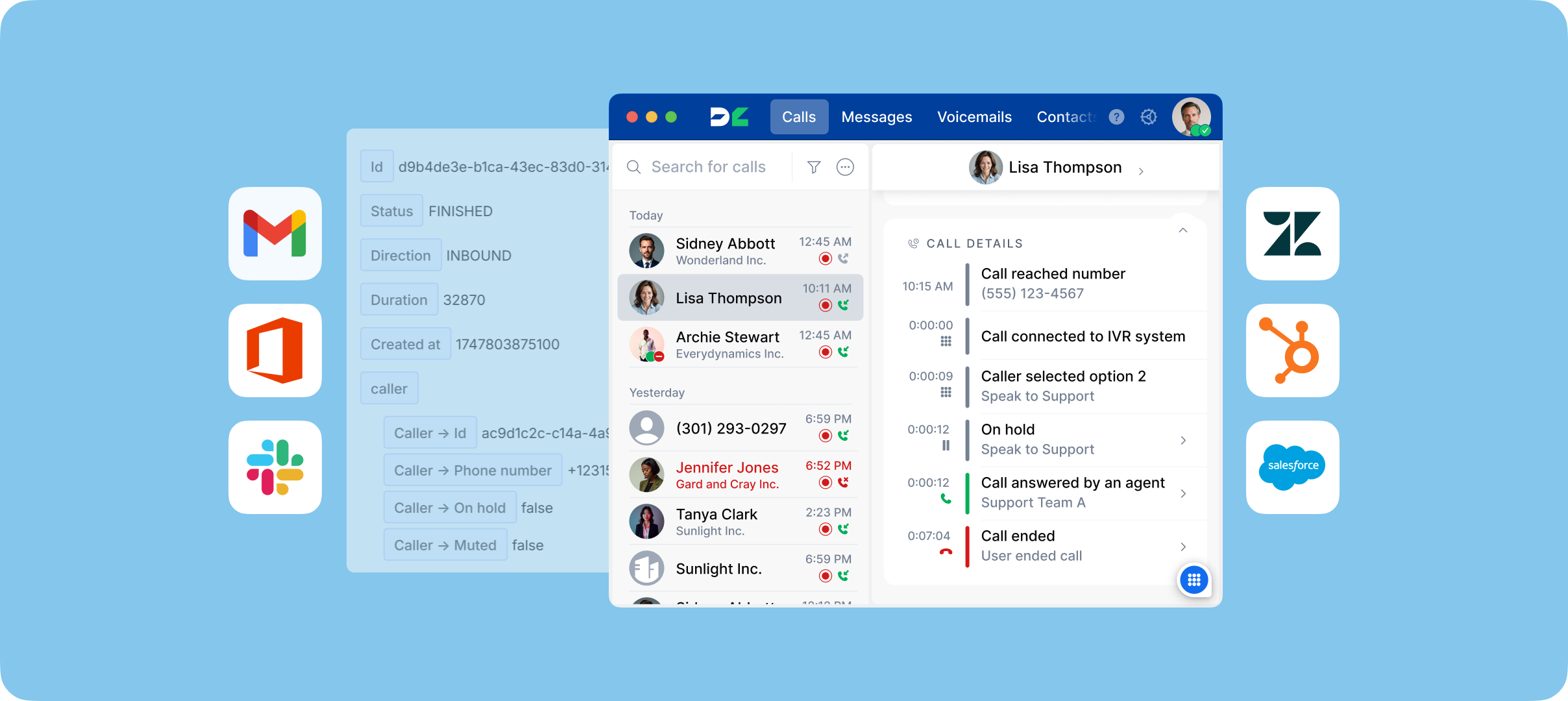
Device Flexibility
A key advantage of cloud contact centers is device flexibility. Agents can access the platform from desktops, laptops, or mobile devices, ensuring they stay connected wherever they work. Cloud solutions support both softphones and VoIP desk phones, making it simple to operate from any location with an internet connection.
Security and Compliance Features
Providers adhere to strict security protocols, including data encryption, access controls, and compliance with standards like GDPR, HIPAA, or PCI DSS. These safeguards protect sensitive customer data and ensure regulatory compliance.
Reporting and Analytics
Built-in analytics provide insights into call volumes, agent performance, customer satisfaction, and overall operations. With real-time dashboards and historical reports, businesses can identify trends, optimize workflows, and make data-driven decisions.
Enhance Your Cloud Contact Center with AI
AI is an absolute necessity for any modern software. In contact centers, it brings significant benefits, not only by automating repetitive tasks but also by taking on more independent roles.
MCP-Enabled AI Voice Agents
AI voice agents can m routine customer interactions, allowing human agents to focus on complex tasks. When connected through an MCP (Model Context Protocol) server, these AI agents integrate with your business systems to retrieve information and execute more advanced processes. This enables them to take actions such as checking inventory, updating CRM records, and act as active participants in workflows.
If the expertise of the AI voice agent is not enough, it will transfer the call to a human agent with full context, ensuring a smooth handoff.
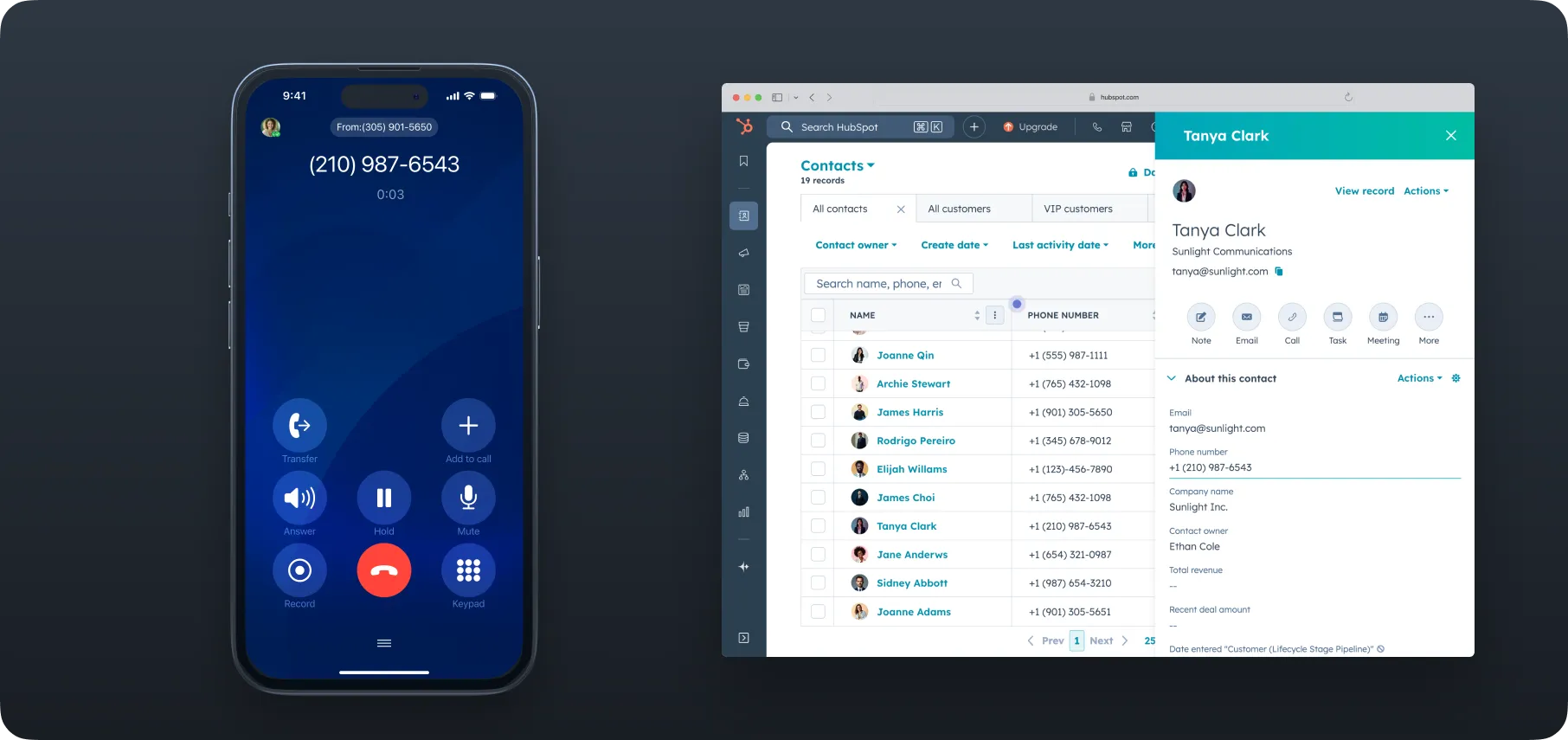
AI Call Intelligence
AI can analyze conversations in real time, generating automatic summaries and highlighting key action items so agents don’t waste time on manual notetaking. They can also capture customer sentiment during a call and organize interactions with predefined tags, making it easier to track, search, and follow up on conversations.
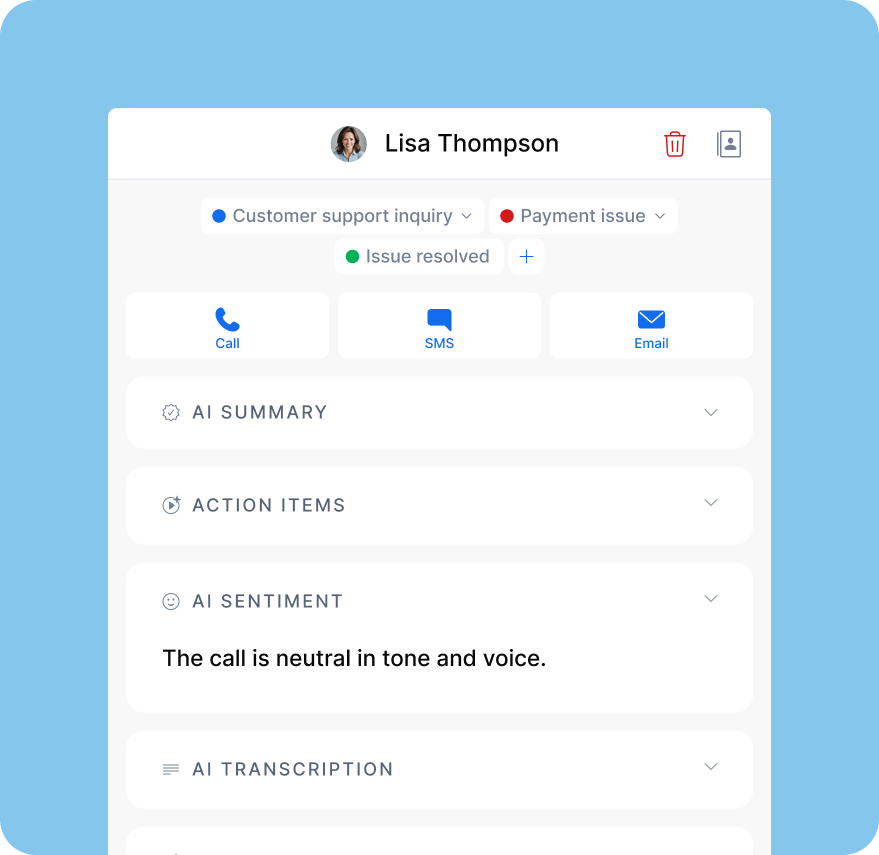
AI Analytics
With AI analytics, businesses can move beyond basic call reporting to uncover deeper insights. AI can identify trends across thousands of interactions, highlight recurring issues, and even predict customer behavior. These insights empower leaders to refine processes, improve training, and anticipate customer needs before they become problems.
Conclusion
A cloud contact center is more cost-effective and scalable than traditional on-premises systems. By adopting a cloud-based solution, even small businesses can leverage advanced customer service tools once reserved for large enterprises and deliver professional, responsive support to their clients.
Looking for a cloud contact center solution? DialLink’s business phone system combines robust call handling, AI-powered automation, and business messaging features to help you build a modern cloud contact center. Best of all, it’s designed with small businesses and startups in mind, making it easy to launch, manage, and scale as you grow.
An on-premises contact center requires businesses to purchase and maintain hardware like servers, PBX systems, and phone lines on-site. A cloud contact center, by contrast, is hosted in the provider’s infrastructure and accessed over the internet.
CCaaS stands for Contact Center as a Service. It’s a subscription-based model where all the technology and infrastructure you need to run a contact center are delivered through the cloud. Businesses pay only for what they use without managing the hardware themselves.
Key features include IVR menus, call routing (ACD), voicemail management, call recording, analytics, and multichannel or omnichannel communication. Look for integrations with CRM or help desk software, device flexibility, and built-in security features. Many platforms also now include AI-powered tools that automate many routine tasks.
Absolutely. Cloud solutions level the playing field by giving small businesses access to enterprise-grade features without the heavy upfront investment. They’re easy to launch, simple to manage, and scalable as your business grows, making them ideal for startups and SMBs who does not have a dedicated IT teams to run complex contact centers.
In this article
- What Is a Cloud Contact Center?
- How Does a Cloud Contact Center Work?
- Cloud-Based vs On-Premises Contact Center: Why Are Businesses Moving to Cloud
- Types of Cloud Contact Center
- Benefits of Cloud Contact Center
- Key Features of a Cloud Contact Center Software
- Enhance Your Cloud Contact Center with AI
- Conclusion

Arina Khoziainova
Content Writer at DialLink
Arina is a content writer with over 7 years of experience in the IT industry. At DialLink, she creates clear, insightful content that helps small business and startup owners simplify communication and drive growth using modern tools. With a strong focus on practical value, Arina transforms complex topics into accessible, actionable stories.
Keep Reading

Google Voice Auto Attendant: What It Is and How It Works
Explore how Google Voice auto attendant works and whether it’s right for your small business.
December 22, 2025
9 minutes

Understanding Inbound Calls and How to Handle Them
Learn what inbound calls are, why they matter, and how to handle them efficiently.
November 27, 2025
11 minutes

What Is a VoIP Phone System?
Read about what a VoIP phone system is, how it outperforms traditional setups, and the main ways it’s used in everyday communication.
October 20, 2025
14 minutes

What Is a Virtual Phone System?
Learn what a virtual phone system is, how it works, and why it’s becoming the preferred communication solution for modern businesses.
October 17, 2025
10 minutes